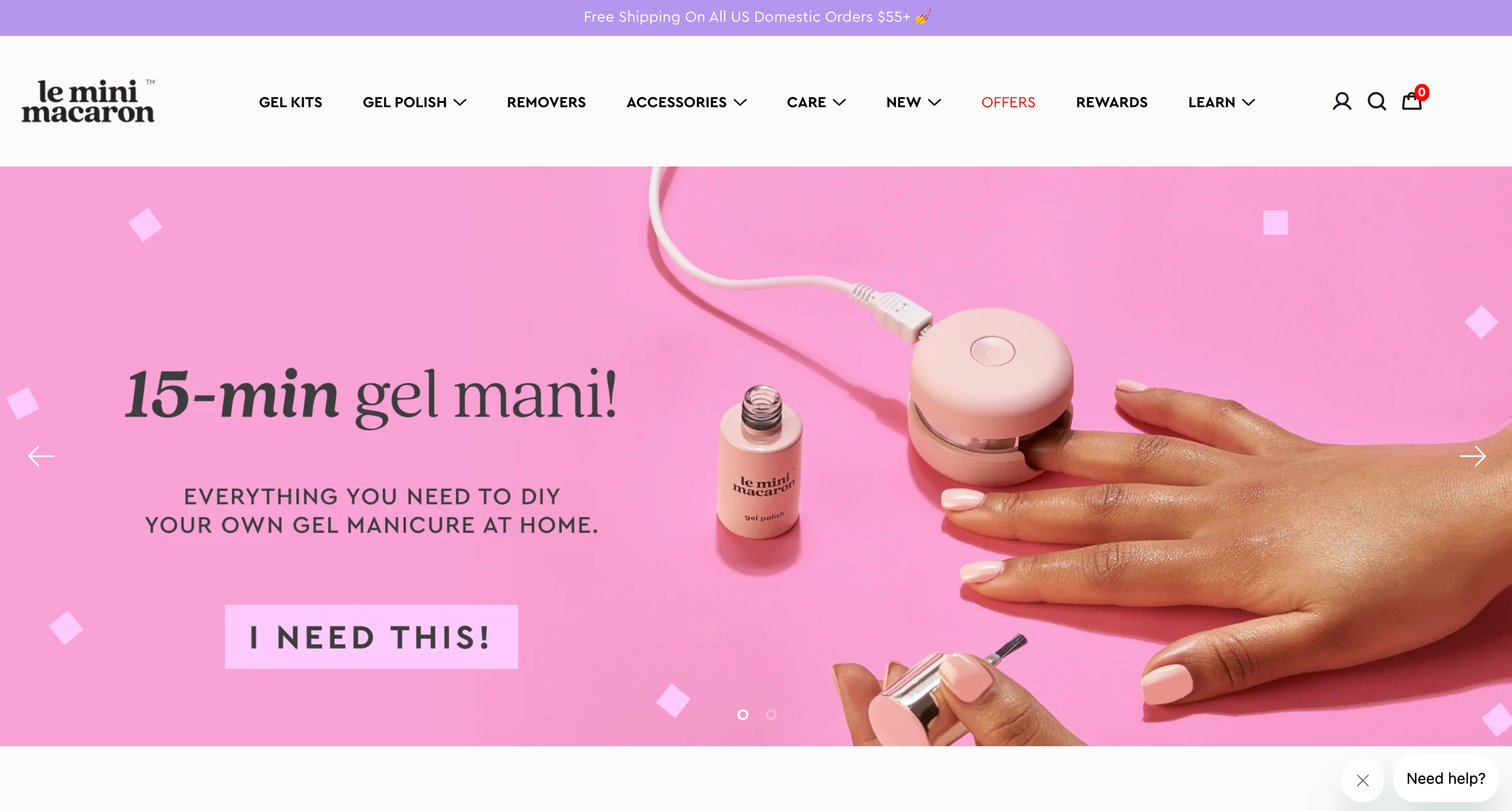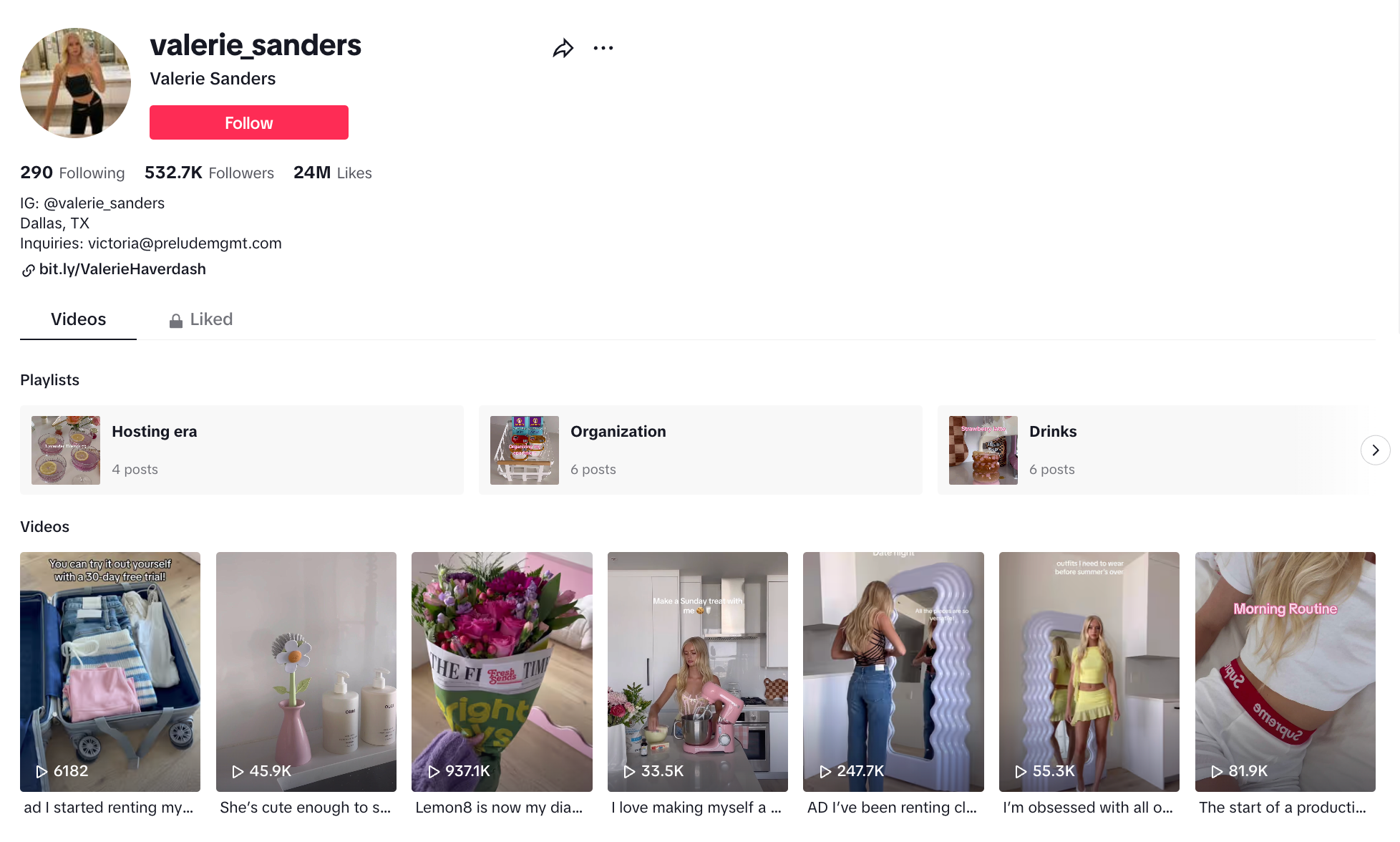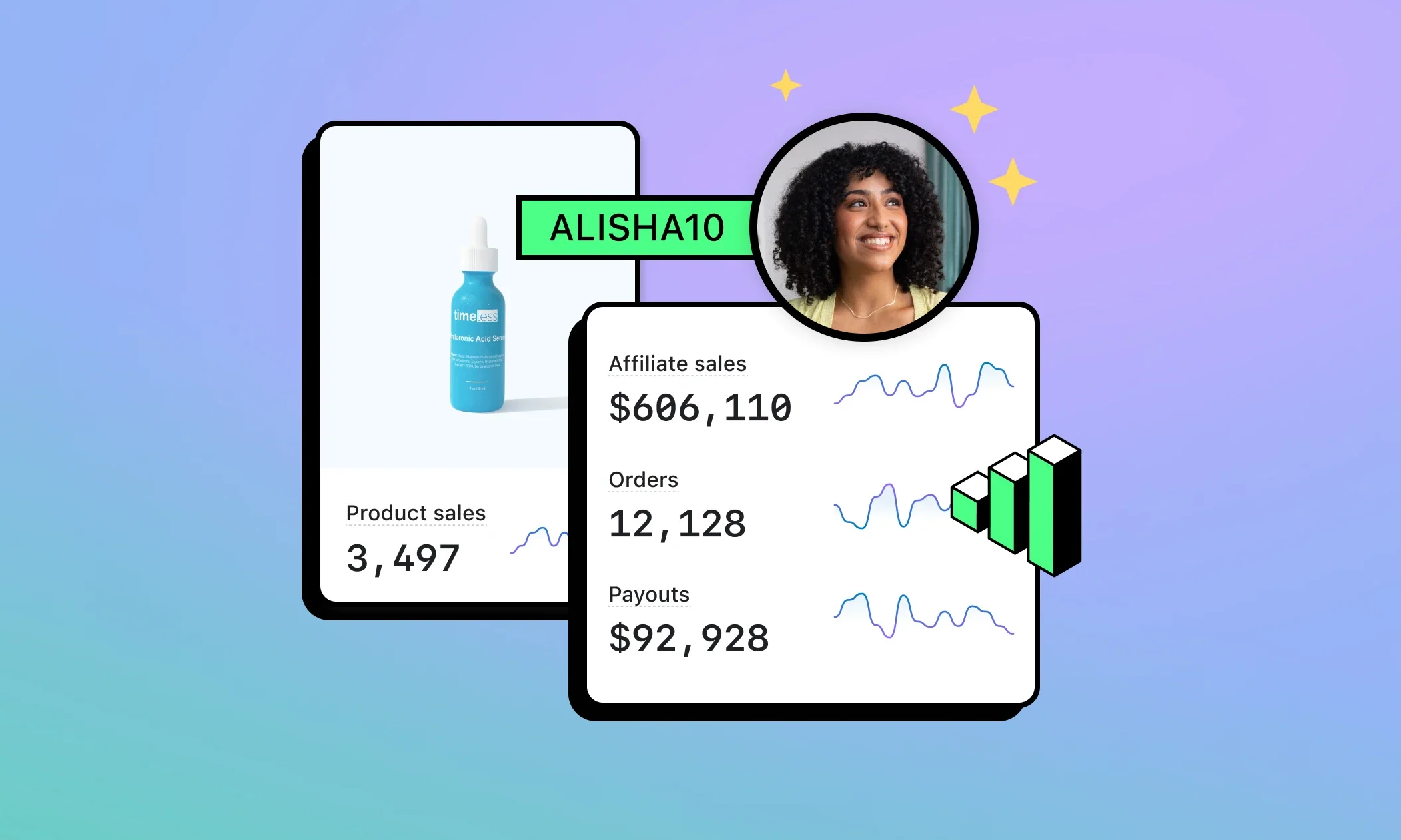How to create an affiliate link

Today’s shoppers expect to be able to access products wherever they spend time online. Whether they’re scrolling through social media posts, visiting blogs, videos, or websites, product links are now a common sight.
As a result, consumers are becoming increasingly comfortable with referral links, especially those from trusted businesses, creators, and brands.
The affiliate marketing industry is expected to reach $15.7 billion by 2024. Here’s how to use affiliate links to maximize the effectiveness of your marketing.
Learn how to create affiliate links, the benefits for your brand, and real-world examples.
What are affiliate links?
Affiliate links are URLs that contain a unique ID that allows brands to track traffic and conversions in order to pay commissions to marketing partners.
When an affiliate partner (the creator, influencer, or publisher who posts the link) joins a brand’s affiliate marketing program, they receive a unique link to the brand’s website or product page. This link includes the affiliate partner’s unique ID, which allows for conversion tracking.
When a potential customer clicks on a link, the source of the traffic is recorded, and when someone purchases a product using the affiliate link, the brand pays the affiliate marketer a commission for that sale.
Affiliate Link Examples
Creator and affiliate marketer @nailsbyalsn creates content using affiliate products she promotes. In her captions, she encourages her followers to use a unique coupon code when shopping at Le Mini Macaron .
When Allison's followers go to her profile, they can click on the bio link to open a collection of affiliate links.

Clicking on an affiliate link will open Le Mini Macaron's website.

After clicking on the affiliate link in your browser bar, you will see the tracking information in the form of UTM parameters. Alison's Le Mini Macaron affiliate link is:

Shoppers and affiliate partners do not need to worry about tracking information in affiliate links. In this case, additional elements in the URL indicate:
- Affiliate link will take you to our online store: " www.leminimacaron.com "
- Affiliate partner has a unique code: "dt_id=526842"
- Affiliate link generated via Shopify Collabs: "utm_campaign=shopifycollabs"
What is Affiliate Marketing?
Affiliate marketing is a referral marketing technique in which affiliate partners earn commissions by promoting products or services through affiliate links.
Companies pay affiliate partners for specific outcomes, such as clicks and conversions (e.g., website visitors signing up for a newsletter or becoming a paying customer). Affiliate marketing can be done through a variety of channels, including TikTok video content, email marketing, blogs, and podcasts.
What are some examples of affiliate marketing?
Affiliate marketing comes in many forms, but is typically a partnership between a brand and a creator that uses a unique affiliate link to track a promotional code.
In the example of TikTok influencer Valerie Sanders, the bio link leads to Haverdash, a clothing rental brand. The bio includes a tracked affiliate link, so when a potential buyer completes a purchase through that link, Valerie receives credit for the sale. Valerie then receives a commission based on the sale price or a percentage of the order.

When you click on the affiliate link and go to the Haverdash website, you will see a link like this, which contains a unique code to identify Valerie:

She promotes her brand with video content like this one to encourage her followers to use her affiliate links.
As another example, affiliate marketer and Instagram user @weimaraner_blue_est2020 promotes products using unique promo codes.
6 Benefits of Using Affiliate Links
- Enhanced authenticity
- The Growth Potential of Affiliate Marketing
- Additional responsibility
- Opportunity to build relationships
- Ease of use and efficiency
- Improve SEO
Brands strategically and naturally grow their customer base through affiliate marketing. Some of the potential benefits that using affiliate links can provide to brands include:
1. Enhanced authenticity
Affiliate marketing can feel authentic because customers click on your affiliate link through a website or source they already trust. Therefore, successful affiliate marketing helps reduce the time it takes to build customer loyalty through a relationship with your affiliate partner.
2. The Growth Potential of Affiliate Marketing
Affiliate sales are likely to continue to grow. The industry is expected to grow at an average of about 10% per year . More than 80% of U.S. businesses use affiliate marketing as part of their sales strategy.
3. Additional responsibility
Working with affiliate partners gives you access to sales metrics and data. Brands can collect sales analytics data from affiliate partners through a variety of tracking methods, such as cookies, pixels, and postback URLs. This information helps brands tailor effective marketing campaigns.
4. Opportunity to build relationships
Using affiliate links is beneficial for both the affiliate partner and the brand. The business benefits from increased traffic, and the affiliate marketer earns revenue through commissions. This helps strengthen the relationship with a valuable brand partner.
5. Ease of use and efficiency
The initial costs associated with affiliate marketing are low, and the potential for a high return on investment (ROI) is high. You don’t need to hire an advertising agency or buy advertising space. Instead, your affiliate partner can market your physical product or service for you, and you only pay them a percentage of the sale if they successfully drive a consumer to purchase the product or service.
6. Improve SEO
Using affiliate links can improve your search engine optimization (SEO) because other websites link to your site. This sends a positive signal to Google about your site’s relevance and its ranking on the Search Engine Results Page (SERP). As a result, the increased search traffic can drive more people to your brand’s website. Affiliate partners know how to create fresh content and rank well in search engines, which can be a vital part of a successful marketing strategy.

How to create affiliate links
- Log in to Affiliate Tools
- Add Affiliate Partner
- Create an affiliate link
- Customizing URLs
- Define a promotion
Affiliate links can help you increase your business’ visibility and generate new revenue. Here are some key steps to creating your own affiliate links:
1. Log in to Affiliate Tools
Log in to your affiliate management app or tool. Here you can track your affiliate partners and their performance. If you use an affiliate management platform, you can post information about your affiliate partners’ sales, products, and affiliate campaigns through your dashboard. You can also create links, find new affiliate partners, and analyze metrics and data.
2. Add Affiliate Partner
Add new affiliate partners to your affiliate program. Affiliate management platforms provide a large affiliate network to help you find new partners. Search by name and market niche to find the right affiliate partner for your product or service.
3. Create an affiliate link
Go to your affiliate dashboard and create unique affiliate links for each of your affiliate partners. Name the links descriptively based on the product or service you are advertising. Some affiliate platforms may create SubIDs to direct customers to specific features or places on your website (e.g., customized landing pages). Each affiliate link is associated with a cookie, which allows you to track the cookie associated with the affiliate partner.
4. Customizing URLs
Many affiliate platforms offer the ability to customize your affiliate link URLs. Most auto-generated URLs are just a string of random letters and numbers. Customizing your affiliate links can help you create a more memorable and less cluttered URL for your customers. For example, the Amazon affiliate program creates a custom URL for each affiliate product link. This isn’t a required step, but it’s something that can make a good impression on your affiliates and readers.
5. Define a promotion
Define a promotional structure that will most effectively motivate your affiliates and prospects. This may include:
- Associate your link with a promotional discount or giveaway
- Determining which channels are high priority for your campaign
- Determine if the campaign is ongoing or time-limited (e.g. a campaign that only runs for a limited time can create a sense of urgency to get affiliate link clicks)
Experiment with commission structures to maximize your return on investment. The Federal Trade Commission (FTC) requires affiliate partners to disclose their connections to products or services.
💡Tip: If you don’t have the time or resources to manage your own affiliate marketing program, consider hiring an affiliate manager to oversee your affiliate campaigns. They can recruit new affiliates, manage onboarding, and provide customer service on your behalf.
The Need for Affiliate Marketing Programs
Why Your Business Needs an Affiliate Program Affiliate programs are an effective way to drive ecommerce traffic, increase sales, support marketing campaigns, and build brand awareness. Starting an affiliate program is relatively easy because there are few fixed costs for marketing.
Key steps include identifying your niche, researching which affiliates are best suited for your brand or working with affiliate networks, generating affiliate links to increase your business revenue and helping affiliates earn commissions.
Affiliate Link Creation FAQ
Can anyone create affiliate links?
Anyone who runs an affiliate program can create their own affiliate links. You can build your program using affiliate platforms such as Refersion, ClickBank (integrates seamlessly with Shopify), Rakuten, and Amazon Associates. These platforms provide useful tools to track affiliates and monitor performance.
How much does an affiliate program cost?
While the marketing of the program itself may be free, the initial cost of joining an existing affiliate network or subscribing to an affiliate management app can range from free service to up to $2,000, depending on the size of the network. Networks typically charge a transaction fee based on a minimum number of transactions per month.
How much do affiliate links pay publishers?
Affiliate marketing programs vary in the incentives they offer to their affiliate partners. Some programs pay a certain amount per sale, while others offer a percentage. There are also affiliate programs that only reward free or discounted products. For example, Amazon affiliates earn between 1% and 20% commission per sale, depending on the product category.
Do affiliate links pay per click?
Affiliate links can use payment models such as pay-per-click (PPC), pay-per-action (PPA, e.g. newsletter subscriptions), and pay-per-lead (PPL), which pays for each lead generated through the affiliate’s platform. However, the most popular compensation structure is pay-per-sale, which pays a percentage of commission each time your affiliate link leads to a sale.
Why should I do affiliate marketing?
Affiliate marketing is worth considering as it provides an additional avenue to increase online sales of your products or services and build brand awareness.
